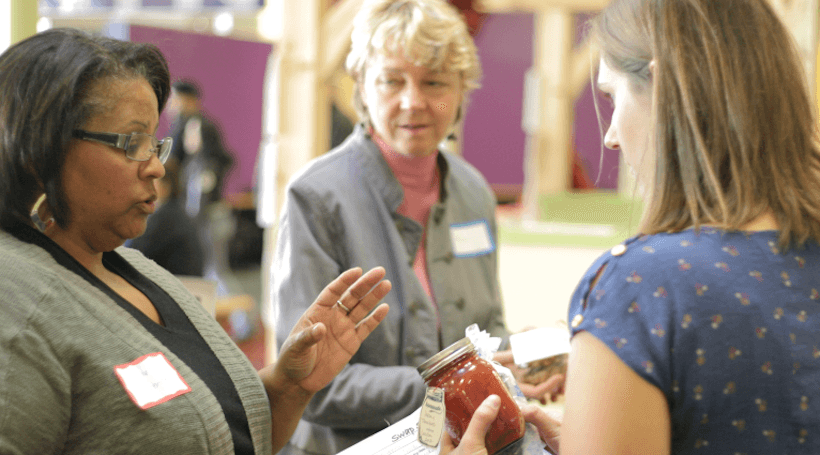To passersby, it’s easy to mistake the sampling of sweets, jams and soups set out on tables in a busy Vineland marketplace for a gourmet food stand.
Yet anyone who tries to buy Abi Douglas’ bacon caramel whiskey bark, Marlise Gross’ gingerbread baby cakes or Amy Dalio’s cheesy quinoa will be disappointed. These inventive cooks and bakers won’t take money for their delectable edibles. They will, however, trade for foods that pique their interest.
That, you see, is how food changes hands among SJ’s small but vibrant food-swapping community.
“It’s a little bit of a show-off thing,” explains Douglas, a Galloway Township resident who arrived at the South Jersey Swappers swap at the Landis Market Place with nine homespun creations. Her bounty included peppermint Oreo truffles, turkey stock and – for the vegans among them – Pumpkin Pie Spice Lara Bars. “I plan ahead to find good recipes I want to try and always come home with really cool stuff that’s usually a little adventurous.”

While not widely recognized in mainstream circles, swapping is truly the foodie trend of the moment. Resurrecting the art of bartering that our ancestors once engaged in for survival, modern-day food swapping is an opportunity for cooks, canners, bakers, backyard farmers and other DIY enthusiasts to connect with likeminded members of their community. At regular intervals, they meet to offload surplus goods and to find challenge, inspiration and enjoyment from others’ creative concoctions. Thanks to social media, the connections are easily made and sustained as swappers share their recipes and love of foods between events.
“It feels like I’m bringing home all these presents,” says Gross, a Cherry Hill stay-at-home mother of five-year-old twins who says she “bakes for sanity.” She blogs about food and has attended nearly every South Jersey Swap. “A lot of the women package their food so creatively with ribbons and bags. It’s exciting to see what everyone else will come up with.”
The modern movement is believed to have started about two years ago in Brooklyn with a simple trade between two self-professed penny-pinching friends: a beekeeper and a canner. As they swapped their surplus foods, they launched plans for trades involving other friends whose foodie skills included foraging, pickling, baking, cooking and brewing. From its New York City roots, swapping has spread to Boston, Austin, San Francisco and beyond. Closer to home, swaps take place in Philadelphia, both Lower and Upper Bucks counties and, since May, Southern New Jersey.
Its popularity has even spawned a trade association of sorts. The Food Swap Network, a not-for-profit group dedicated to promoting food swapping and collective food sharing, was formed last year by swap enthusiasts nationwide. Its website lists contact information for dozens of swaps taking place on a regular basis worldwide and includes advice for foodies who want to start new groups. In 2011, swapping was named by an environmental news website as one of the top food trends of the year.
But perhaps its legitimacy was cemented when swappers encountered their first full-fledged controversy. As swappers in Lake Tahoe, Nev., were readying for an event in the fall of 2011, the Nevada County department of environmental health shut it down, saying the swap was illegal because it was held at a public facility where food has to come from approved sources, such as a restaurant or commercial-grade kitchen. As a result, the Slow Food Lake Tahoe group now meets at private homes as it lobbies officials to allow public swaps.
Given SJ’s “Garden State” traditions and love of “farm to fork” principles, it’s not surprising that swapping has been embraced by many in the region. The idea was first cooked up when 30-year-old Lauren Vitagliano read about a swappers group in a Sarasota, Fla., magazine while visiting her mother. Intrigued, she decided to start her own group closer to home in Vineland after she found out there were no organized swaps in New Jersey. (Since then, groups have cropped up in North Jersey and Bradley Beach.)
From the first event last May, in which eight women met in a Vineland bakery, SJ-style swapping has grown in size and sophistication, says Vitagliano, who works for the Federal Aviation Administration as an airport research specialist by day but she says she considers cooking, baking and blogging about food her passion.
A swap they organized at the end of last year — the groups fifth — attracted 16 participants. The kitchen and garden bounty included diverse selections: Jerusalem artichokes, candied cranberries, crema de limoncello, lavender soaps, hand-knit scarves and “100-percent pure undiluted earthworm castings.”
“It was our best swap yet,” boasts Vitagliano, who maintains the Food Swappers BlogSpot and Facebook site, which has 184 followers. “Not only did we have the most swappers, but each swapper had multiple items. People are starting to catch on that having more than one item increases your swapability.”

Following principles recommended by the Food Swap Network, the SJ swaps are a two-hour affair in which the first hour is devoted to tasting and talking. Participation is free but swappers are encouraged to register in advance of the event. After setting up samples, with ingredients clearly labeled on index cards, participants are encouraged to stroll around, talking to fellow swappers and trying everyone else’s foods. If something tempts their taste buds, they write their name on an index card next to the coveted foods and suggest what they’re willing to trade.
It’s during the first hour that friendships form and swappers learn about the products they’re sampling. For example, Gross will tell how her gingerbread baby cakes are faithful to a recipe from a classic Julia Child cookbook, which she was assigned to make and write about for the foodie blog “Tuesdays with Dorie.”
Sarah Johnson, a Cedarville resident who came with 13-year-old daughter Emma, volunteers that she learned to make butter, a new skill, for the swap.
And Douglas divulges her hyper-baking drive may stem from the fact that she’s just days away from delivering her second child. “I think this is how I nest,” says Douglas, who gave birth to Urijah Phillip at the end of last year. “I make food for people.”
As the second hour approaches, Vitagliano announces the swapping should start. Participants check their index cards to find out who wants their goods and the trading begins.
For Amy Dalio of Maple Shade, there is excitement in picking up something she would never have thought of trying herself. Among her trades, she obtained the garden-grown Jerusalem artichoke, a lesser-known root vegetable that looks like ginger and has nothing to do with Israel or artichokes.
“It’s not something I would pick up in a grocery store because I wouldn’t have known what to do with it,” says Dalio.
The actual swapping seems to happen at lightening speed after the long build up. Participants make swaps until there is nothing left to trade: candied cranberries for salsa, a scarf for the herbed butter, and so it goes. As they pack up coolers, all go home with very different bounty than they carried in.
As swapping builds its reputation in New Jersey, Vitagliano envisions a day in the not-too-distant future when it becomes a more regular pastime that inspires more cooks, gardeners and other DIYers to greater creative heights.
“I’d love,” she adds, “to see the tickets sell out the same day they are announced, like they do at some of the bigger swaps around the country.”
The next South Jersey Swap will be held on February 2 from 10 am to noon at the Landis Marketplace in Vineland.














